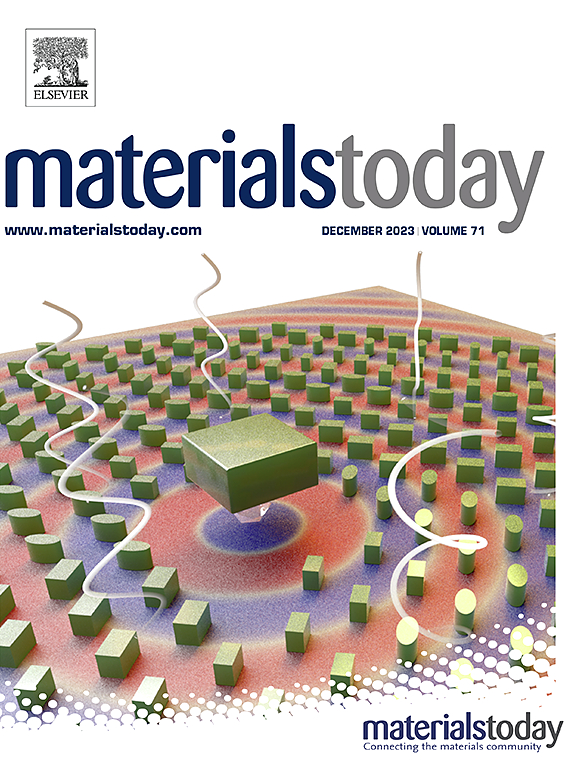高性能低体积膨胀锂金属电池的颗粒内镀合金反应
IF 21.1
1区 材料科学
Q1 MATERIALS SCIENCE, MULTIDISCIPLINARY
引用次数: 0
摘要
锂金属阳极是高能锂离子电池的关键组成部分,但目前还缺乏实现稳定充放电循环和低容量膨胀的锂金属阳极的解决方案。本文报道了一种具有高可逆性和低体积膨胀的颗粒内镀锂合金反应。一种独特的颗粒结构,包括多孔亲石硅芯和双导电密封,同时实现了高孔隙率和低颗粒表面积。这种分层结构的微粒实现了超高容量(~ 4292 mAh/gSi)的颗粒内锂存储,大大减少了电极膨胀并提高了循环寿命。在~ 1 mA cm - 2和~ 3mAh cm - 2下工作的半电池实现了库仑效率>;在碳酸盐电解质中循环250次后,电极的回收率为99.3%,循环后的电极显示出良好的孔隙度和屏蔽的电解质渗透。相比之下,没有保护密封的多孔硅颗粒会发生剧烈的副反应和粉碎,电极会出现严重的肿胀和容量衰减。具有LiNi0.8Co0.1Mn0.1O2 (NCM811, ~ 20.3 mg cm−2)的全袋电池在100次循环后保持了~ 77.9%的容量,其中密封的多孔硅经历了轻微的膨胀(~ 12%),远低于~ 20 μm锂金属阳极(~ 70%)。此外,采用双面密封多孔微粒阳极的Z-stack全袋电池在50次循环中提供了约95.7%的容量保持率。本文章由计算机程序翻译,如有差异,请以英文原文为准。
Intraparticle alloying-plating reaction for high-performing lithium metal batteries with low volume expansion
Lithium metal anode is a key enabler for high-energy lithium-ion batteries, however solutions to achieve lithium metal anodes with stable charge–discharge cycling and low volume expansion have been lacking. Here, an intraparticle lithium-alloying-plating reaction offering high reversibility and low volume expansion is reported. A unique particle architecture, comprising a porous lithiophilic silicon core with a dual conductive seal, was constructed to concurrently achieve high porosity and low particle surface area. This hierarchically structured microparticle achieved intraparticle Li-storage with ultrahigh capacity (∼4,292 mAh/gSi), greatly reduced electrode swelling and improved cycle life. Half-cells operating at ∼1 mA cm−2 and ∼3mAh cm−2 achieved coulombic efficiency > 99.3 % after 250 cycles in carbonate electrolyte, with the post-cycled electrodes showing well-preserved porosity and shielded-off electrolyte penetration. By contrast, porous silicon particles without the protective seal, experienced drastic side reactions and pulverization, with the electrodes experiencing severe swelling and capacity decay. Full pouch cells with LiNi0.8Co0.1Mn0.1O2 (NCM811, ∼20.3 mg cm−2) retained ∼77.9 % capacity after 100 cycles, where the sealed porous silicon experienced minor expansion (∼12 %), much lower than a ∼20 μm lithium-metal anode (∼70 %). Furthermore, Z-stack full pouch cells adopting double-sided sealed porous microparticle anodes delivered a capacity retention of ∼95.7 % over 50 cycles.
求助全文
通过发布文献求助,成功后即可免费获取论文全文。
去求助
来源期刊

Materials Today
工程技术-材料科学:综合
CiteScore
36.30
自引率
1.20%
发文量
237
审稿时长
23 days
期刊介绍:
Materials Today is the leading journal in the Materials Today family, focusing on the latest and most impactful work in the materials science community. With a reputation for excellence in news and reviews, the journal has now expanded its coverage to include original research and aims to be at the forefront of the field.
We welcome comprehensive articles, short communications, and review articles from established leaders in the rapidly evolving fields of materials science and related disciplines. We strive to provide authors with rigorous peer review, fast publication, and maximum exposure for their work. While we only accept the most significant manuscripts, our speedy evaluation process ensures that there are no unnecessary publication delays.
 求助内容:
求助内容: 应助结果提醒方式:
应助结果提醒方式:


